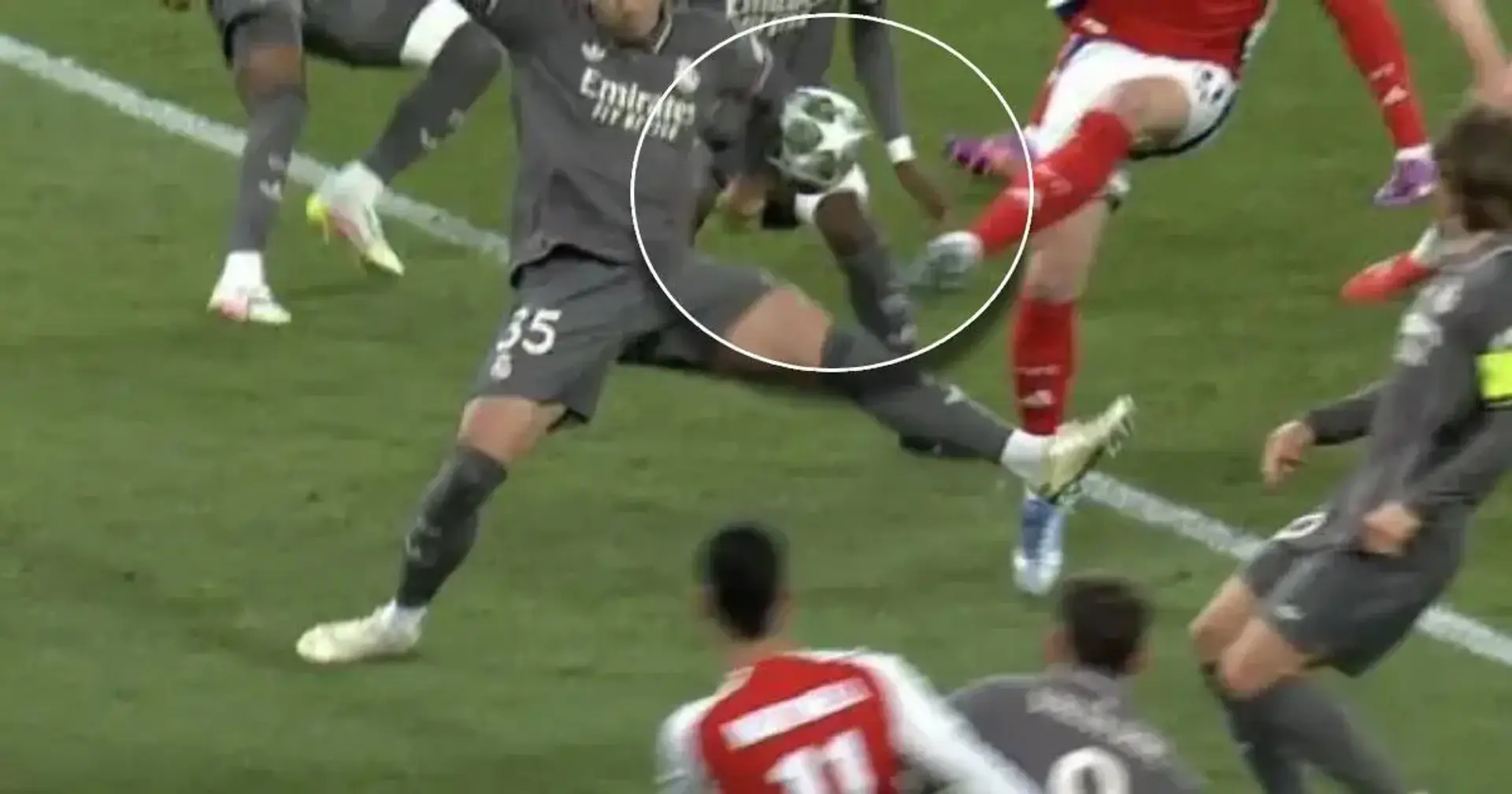Sport
Former Referee Iturralde on Asencio’s Handball After Rice’s Shot: ‘It’s Not a Penalty’

The highly anticipated Champions League quarter-final first leg between Arsenal and Real Madrid, played at a vibrant Emirates Stadium in London, witnessed a moment of significant controversy that has ignited fervent debate among fans and pundits alike. The incident in question occurred in the 13th minute of the tightly contested encounter, which ended goalless at halftime, and involved a potential handball by Real Madrid defender Raul Asencio following a shot from Arsenal midfielder Declan Rice just outside the penalty area.
The trajectory of Rice’s powerful strike saw the ball make contact with Asencio’s hand at close range within the Real Madrid penalty box. The Arsenal players and their supporters vehemently appealed for a penalty, believing that Asencio had handled the ball in a manner that warranted a spot-kick. Consequently, the Video Assistant Referee (VAR) officials reviewed the incident, meticulously examining the available footage from various angles to determine whether a clear and obvious error had been made by the on-field referee, Irfan Pelto.
Following their review of the replays, the VAR officials ultimately decided against recommending a penalty, and the referee, Irfan Pelto, was not instructed to consult the pitch-side monitor for a personal review of the incident. This decision, broadcast live to a global audience, has been met with considerable discussion and varying interpretations, particularly among the Arsenal fanbase who felt aggrieved by the outcome.
To shed further light on the contentious incident and provide expert analysis from a refereeing perspective, former Spanish international referee Eduardo Iturralde Gonzalez, a respected voice in the world of officiating, offered his assessment of the potential handball. In his evaluation of the moment when the ball struck Raul Asencio’s hand, Iturralde Gonzalez stated his professional opinion that the incident did not constitute a penalty offense under the current Laws of the Game.
Providing a detailed rationale for his conclusion, the former referee explained his interpretation of Asencio’s hand positioning and the circumstances surrounding the contact. “In my opinion, it’s not a penalty because his hand was lowered, but it’s very close,” Iturralde Gonzalez acknowledged the proximity of the ball to Asencio’s hand at the moment of impact, a factor often considered in handball decisions.
However, he further elaborated on the key elements that led him to believe a penalty should not have been awarded. “The hand was in a natural position, it didn’t increase [the body’s surface area], and the shot was taken from half a meter away, so Asencio couldn’t move his hand,” Iturralde Gonzalez emphasized that Asencio’s arm was not extended in an unnatural manner to deliberately handle the ball and that the close range from which Rice’s shot was struck limited the defender’s ability to react and avoid the contact.
Iturralde Gonzalez’s expert analysis aligns with the decision made by the VAR officials during the match, suggesting that the contact between the ball and Asencio’s hand was not deemed to be a clear and obvious handball offense according to the prevailing interpretations of the Laws of the Game. His explanation highlights the crucial factors that referees and VAR officials consider when assessing potential handball incidents, including the position of the arm, whether it makes the body unnaturally larger, and the proximity of the ball to the defender.
The incident involving Raul Asencio and Declan Rice serves as another example of the often-subjective nature of handball decisions in football and the ongoing debates surrounding the interpretation and application of the relevant rules. While Arsenal fans may understandably feel that a penalty should have been awarded, the perspective of a former referee like Iturralde Gonzalez provides valuable insight into the reasoning behind the officials’ decision not to penalize Asencio for the contact. The debate surrounding this incident is likely to continue among fans and pundits, underscoring the complexities and controversies that often arise in high-stakes Champions League encounters.

 Sport11 months ago
Sport11 months ago“I’m not trying to criticize Ancelotti, but I’m not happy with him for benching that player”: Bellingham Expresses Frustration Over Ancelotti’s Tactical Decision

 Sport11 months ago
Sport11 months agoBREAKING: Manchester City vs Liverpool Clash Cancelled! Title Race Takes a Twist

 Sport11 months ago
Sport11 months agoArsenal Poised for January Swoop on €70 Million Star Dusan Vlahovic

 Sport11 months ago
Sport11 months agoWHAT ON GOD’S GREEN EARTH DID WE JUST SEE?!

 Sport11 months ago
Sport11 months agoReal Madrid: Carlo Ancelotti’s Surprising Revelations About an Unexpected Quality of Vinicius

 Sport11 months ago
Sport11 months agoBREAKING: Arsenal’s Champions League Quarterfinal Opponent Revealed After Monaco’s Dramatic Win – Tough Challenges Await Arteta’s Men

 Sport11 months ago
Sport11 months agoChelsea Players Facing Suspension as Yellow Cards Mount

 Sport11 months ago
Sport11 months agoKey Arsenal Player Set for Return as Gunners Face Struggling Everton
















